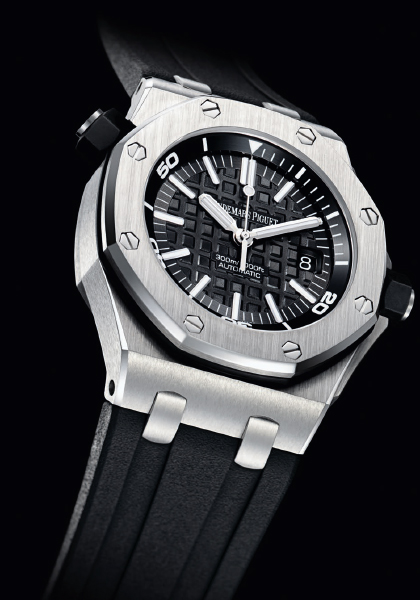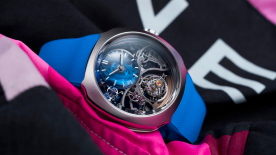The Royal Oak Offshore (ROO) Diver 15703ST was officially launched in 2010, but it was by no means the first-ever dive watch from Audemars Piguet. That honour goes to the 35-piece Royal Oak Offshore Scuba Wempe Limited Edition 15340OR produced in 2005 and which features a gold case and bezel as suggested by the letters “OR” (French word for gold) in its reference. What followed was a further release of 175 ROO Scuba limited-edition pieces in steel.
Interestingly, the ongoing trend in this new millennium of using bronze for watch cases and bezels began slightly over a decade ago, most likely with a dive watch. Audemars Piguet is one of the forerunners, but in 2010, when the ROO Scuba was renamed ROO Diver, the case and bezel were made of steel.
Although Audemars Piguet pioneered the concept of the luxury sports watch in 1972, it did not have much — if any — of a dive watch history prior to 2005, even for its Royal Oak and ROO collections. Owners are of course free to engage in water sports along with their watches at their own risk. One Japanese collector went surfing with his ROO 25940OK and it suffered from an accidental smash-up with corals. A full-page image of his damaged ROO was published in a Japanese magazine. Though the watch continued to function, pieces of its black rubber bezel were ripped off, exposing the underlying gold structure.
First unveiled in 1993, the Royal Oak Offshore was specifically designed as a chronograph watch. How does the three-hand Diver fit into this ROO equation? Wouldn’t a three-hand watch theoretically be more suited as a Royal Oak, given that the original only had two hands? That being said, robust dive watches have to withstand the immense pressure experienced at great depths and typically house an anti-magnetic cage. Strong, thick cases and glasses are typical for dive watches. The heftier ROO build was therefore the better option. What’s more, there can be no doubting the seaworthiness of the 300m-rated ROO Diver as it meets the definition of a dive watch, having satisfied ISO 6425 or NIHS 92-11 standards.

From a personal standpoint, using an inner rotating bezel for the dive reference scale is pure brilliance. After all, what is a ROO without its iconic bezel? Similarly, what is a dive watch without a reference diving scale? The configuration of the ROO Diver retains the Royal Oak DNA with the fixed octagonal bezel. More dial space is taken up with a broader flange serving as the inner rotating bezel and overall dial space is well-proportioned. The position of the screwed-in crown at 10 o’clock for the inner rotating bezel may seem a little odd from an operating point of view, but not from an aesthetic perspective. When the ROO is on the wrist, it can be a challenge to unscrew the crown, set the inner rotating bezel and screw the crown back in securely. This isn’t a deal-breaker though, as tghe practical and acceptable solution is to set the diving scale before strapping on the Diver. From a personal perspective, the protruding crown at 10 o’clock is somehow inconspicuous as it is overshadowed by the bezel’s beefy presence.
Similar to the original Royal Oak in steel being a luxury sports watch, the ROO Diver 15703ST is a luxury dive watch in steel and this is duly reflected in its price. It was disruptive to the Royal Oak iteration and for some Royal Oak loyalists during its early days, but it has steadily gained acceptance. This is a hereditary trait, as the very first Royal Oak and Royal Oak Offshore models were also both greeted critically and viewed with scepticism during their infancy.
The attention given to design and detailing is a huge bonus for the ROO Diver. Unlike the earlier ROO Scuba, the ROO Diver features double baton hours hands for the 12 o’clock reference. This is significant as such an hours reference was used in the original 1972 Royal Oak A Series dials (and the much sought-after Royal Oak 157202ST re-edition). The subsequent Royal Oak B and C Series versions, also produced in the 1970s, used the AP logo for the 12 o’clock hour reference.
Is the ROO Diver 15703ST, powered by Audemars Piguet’s in-house Manufacture Calibre 3120 selfwinding movement with 60 hours of power reserve, worth its salt? The answer is evident from the model’s permanent spot in the brand’s collection and its now classic form maintained across almost two decades from the ROO Diver’s earlier origins to its current descendants. One Victor Hugo quote that comes to mind in relation to the ROO Diver is: “Style is the substance of the subject called unceasingly to the surface.” Why? It comes as little surprise to learn that certain ROO Divers enjoy limited or indeed no aquatic life, since it is, after all, a luxury dive watch of substance and style.
This year GMT Magazine and WorldTempus have embarked on the ambitious project of summarising the divers watch since 2000 in The Millennium Watch Book - Divers watch, a big, beautifully laid out coffee table book. This article is an extract. The Millennium Watch Book - Divers watch is available in both French and English here:







